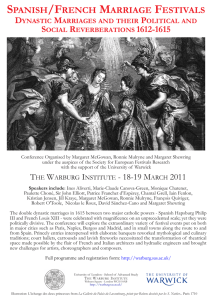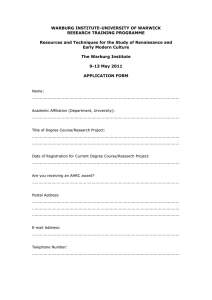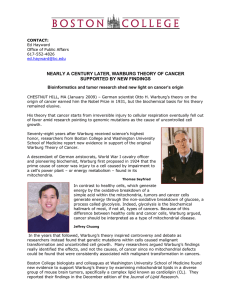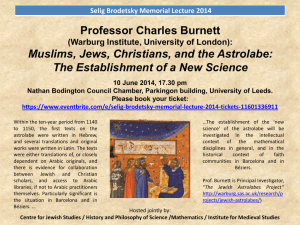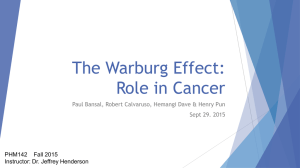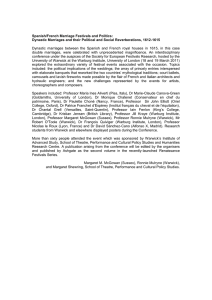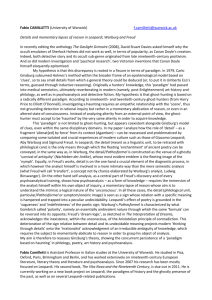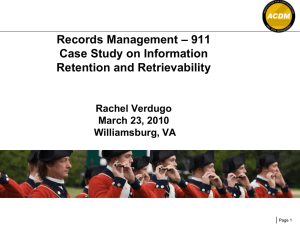T From Event to Memory by Dorothea McEwan
advertisement
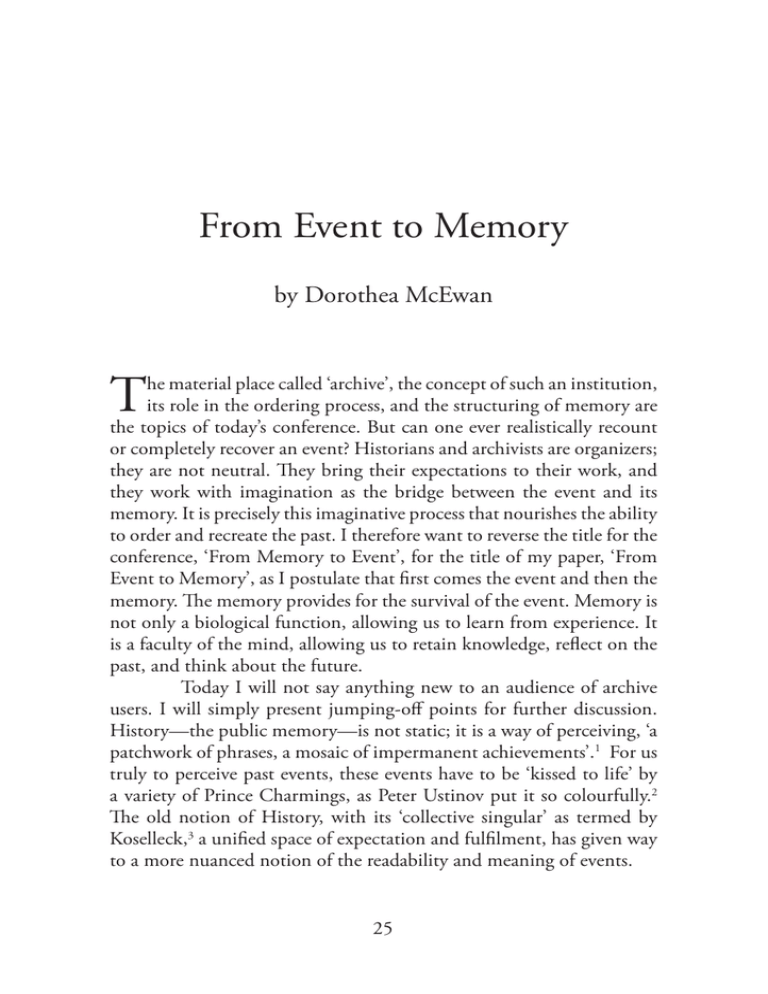
From Event to Memory by Dorothea McEwan T he material place called ‘archive’, the concept of such an institution, its role in the ordering process, and the structuring of memory are the topics of today’s conference. But can one ever realistically recount or completely recover an event? Historians and archivists are organizers; they are not neutral. They bring their expectations to their work, and they work with imagination as the bridge between the event and its memory. It is precisely this imaginative process that nourishes the ability to order and recreate the past. I therefore want to reverse the title for the conference, ‘From Memory to Event’, for the title of my paper, ‘From Event to Memory’, as I postulate that first comes the event and then the memory. The memory provides for the survival of the event. Memory is not only a biological function, allowing us to learn from experience. It is a faculty of the mind, allowing us to retain knowledge, reflect on the past, and think about the future. Today I will not say anything new to an audience of archive users. I will simply present jumping-off points for further discussion. History—the public memory—is not static; it is a way of perceiving, ‘a patchwork of phrases, a mosaic of impermanent achievements’.1 For us truly to perceive past events, these events have to be ‘kissed to life’ by a variety of Prince Charmings, as Peter Ustinov put it so colourfully.2 The old notion of History, with its ‘collective singular’ as termed by Koselleck,3 a unified space of expectation and fulfilment, has given way to a more nuanced notion of the readability and meaning of events. 25 Moveable Type The Importance of Sources Let me tell you a bit about myself. I am a historian and an archivist. I chose history as my intellectual discipline after becoming intrigued by thinkers like Leopold von Ranke, 1795–1886, who so famously opened his History of Latin and German Peoples, 1824, with the words, ‘to show the past as it really was’. Or to put those thoughts into my own words: to let me, in my own writing of history, be guided by scepticism, the primary tool of historians, to go beyond the published sources, and to stick to the building blocks of information, sources, sources, sources. Modern theological treatises speak of the hermeneutics of suspicion, notably about biblical and early Christian council texts and how they have been redacted. Unwanted people, mostly women, or events—mostly manifestations of minority groups against majority groups—have been redacted, and in the case of women, with catastrophic results. A hermeneutic of suspicion towards the dominant version of events and texts produces the best tool with which to rewrite these events and texts. The surveillance of word and image is the role of the historian. The Warburg Institute Archive Where does the archivist come in? Let me start with a look at the Warburg Institute, or as Salvatore Settis termed it, ‘Warburg Continuatus’,4 which I take to mean that Aby Warburg’s thought processes continue in the collection he left behind. The library with its unique classification system, the photographic collection, and the archive, which houses the working papers of Warburg, are operating along Warburg’s conceptual framework. He founded the Kulturwissenschaftliche Bibliothek Warburg in Hamburg, which was transferred to London in 1933. Warburg spent his whole life preoccupied with the investigation of memory, or more precisely Mnemosyne, the Greek word meaning, more specifically, remembrance, the act of remembering as a key to understanding intellectual history from classical antiquity in the Mediterranean basin to Western enlightenment. In Greek mythology, Mnemosyne is the mother of the Nine Muses; she owns all the stories and has the gift of, or the gene for, memory. The collection of past events, history, is only possible through memory. Societies, as coherent entities, could not survive without memory. 26 Moveable Type The Warburg Institute is devoted to the investigation of the continued revivals and metamorphoses of elements of ancient culture in Western thought and the exchange of cultures. Warburg’s collection of papers, books, and images—his continuation—is governed by the principle of the ‘good neighbour’: the physical arrangement of the books as a manifestation of a conceptual order. For Warburg, books and photographs, text and image are the way to the cultural memory of humanity. Both are based on ideas, the confluence and congruence of seeing and understanding. Both text and image present the repository of human expression. With their help, scholars can tap into the life of the past. You may have heard of the Mnemosyne Atlas with which Warburg tried to show how human emotions are expressed [Figure 1]. In the famous Lecture on the Serpent Ritual, Warburg says, ‘I envisage [the Mnemosyne Atlas] […] a collection of documents relating to the psychology of human expression. The question is: how did verbal and pictorial expressions originate; what are the feelings or points of view, conscious or unconscious, under which they are stored in the archives of memory? Are there laws to govern their formation or re-emergence?’5 This statement portrays the triad of the pictorial expression or image, the verbal expression or text, and their unique preservation in an archive of memory that safeguards the mechanisms of image- and text-based reemergence. The Mnemosyne Atlas was a tool for Warburg; photographs were mounted on mobile walls with pins and therefore could be arranged and rearranged depending on what Warburg wanted to show and which development of intellectual history he wanted to document. It became for him ‘an instrument of cultural history which would make the past available to the present’.6 Experimental assemblages took on a life of their own, creating and conveying connections, a school of visual processes just as much as a school of intellectual processes, a means of communicating. The memory of the past, kept in word and image can thus be transmitted and read because it is preserved, and this memory gives inspiration for the future. Mnemosyne’s purpose is to serve research and generate questions. As Warburg wrote in a letter to his friend Fritz Saxl, who became his successor as director of the Warburg Institute, ‘I cannot rate your time and life higher than mine: 27 Moveable Type Figure 1: Mnemosyne Atlas, pl. 55. © The Warburg Institute, London. Moveable Type canon fodder for respectable question marks’.7 To pose questions is the respectable scholarly pursuit and the means to finding answers. It was clear to Warburg that memories could also deceive and that they needed to be investigated with scholarly rigour, which was only possible through the help of corroborating materials. Warburg was interested in the myriad ways of expressing fascination—visual, aural, and emotional—in images and language and music and religions. He studied the ‘paths taken by the mind’, the staging posts in the development of scientific thought, tracing the history of disciplines changing colour: how numerology turned into mathematics; how alchemy gave birth to chemistry; how invocations and incantations evolved into a corpus of religious texts and songs, stories, and literature; how astrology, after many millennia of stored knowledge, became astronomy through mathematical and scientific observations of the celestial sphere. In the case of astrology, the question of what pejoratively is held to be ‘superstition’ was for Warburg an eminently important manifestation of intellectual activity, an ‘Erkenntnisrudiment’8—crude building blocks of knowledge that are also part of the social memory of humanity.9 In the Warburg Institute, the arrangement of the library according to subject topics and the arrangement of the photographic collection according to topics—not according to authors’ or artists’ names—make it possible to underpin text with image, to explain image with text passages. In the archive, the collection of Warburg’s working papers is arranged similarly, with the exception of the huge correspondence collection, which is arranged alphabetically. Thus, the archive complements both of the other two departments, the library and photographic collection, with their subject arrangement. The event leaves behind a memory, and it is this memory that is expressed in image and text. Let me now move from the particular to the more general using a variety of sources and examples of different archives. Peat Bog Archivists are normally not enamoured of dampness. My first example is taken from nature—a peat bog that, luckily for us, has dried 29 Moveable Type out. This particular peat bog in Ireland, with its layers of peat and silt and the inclusion of insects, life forms, plants, and stones deposited and trapped in the bog with their various colours lets us read the ecological story of that particular locality. It presents facts expressed in earth and sand, stone, and insects. It is thus an ecological memory of the activity of the landscape, the bog, over the last 1,000 years. The peat bog has preserved the memory of natural events without any value judgement about what should be preserved and what should not. It is a good example for the ideal of archive work, preservation without any value judgement. This is possible in nature, but not easy in our literate culture, where decisions on what should be preserved are never random, but are influenced by value judgements. Fame A visual example of a value judgement is the engraving ‘Allegory of Fame or on the Eternity of Poetry’ by the Flemish painter Johannes Stradanus, 1581 [Figure 2]. Ariosto visits the empire of the moon and sees the temple of the Parcae, the personifications of destiny, and the goddesses of fate. Stradanus’s engraving depicts an old man, Time, throwing papers into Lethe, the river of oblivion. The papers scatter, and birds try to save them, but only two swans manage to bring papers with the names of historians and poets to shore. These papers are taken from the shore by a nymph to the temple of Fortune, where they are hung for safekeeping in eternity. The papers depict the poems of famous men; their words need preserving—the literate source is the true survivor. The idea that the reputation of an event or a particular person—in this case the poet or praise singer—is important, is the name of fame or the game of fame. Sacred Books This engraving depicts the traditional view that only records about ‘famous’ people were deemed worthy of being kept and collected and consulted. We have moved away from this limited or elite view of archives of famous people only. Ours is a literate culture; our sources are words, music, documents, inscriptions, but also images—think of the arrival of images in books and newspapers—that convey a message. 30 Moveable Type Figure 2: Johannes Stradanus, Engraving, Allegory of Fame. © Gabinetto fotografico Uffizino, 76659, Florence. Moveable Type The value of written sources was understood very early, when imperial succession rested on documenting legal or illegal issues. Another important area to document was land use, and therefore land registers were established. Such sources, royal and administrative, were kept in the best-defended parts of the castle, the muniment rooms in the towers of churches and castles. In the absence of administrative registers, the margins of holy scriptures were filled with entries of local land transactions and property rights. A contemporary instance of a ‘best kept’ place, for example, are manuscript books in churches and villages in the Highlands of Ethiopia and Eritrea. Blank margins in gospel books were used as registers for important land transactions; in the absence of secular books or land registries in the villages, glosses in the margins of sacred books attested to land use and property rights and thus became fixed in people’s memory [Figure 3]. Such manuscript books not only preserve the sacred texts, but also preserve the decisions on land settlement. They are like imperial-succession documents; they are based on an authority that is accepted as the dominant authority. The ownership of assets could be documented, and this documentation became the role of archives. In time, archives came to house mementoes like locks of hair, pressed flowers, ink blotters, scientific curiosities, and artefacts that made archives into Wunderkammern, Wonder Chambers, collections of the weird and wonderful. In German, we have the word verewigen, literally ‘to make something eternal’, that is, to lift something into an altogether different plane, to immortalize or to perpetuate. The key to all this is memory, the importance of keeping something in mind, of documenting it. Then, the community or the individual will not forget it, and it will be made available for future discussions. Archives as Loci of ‘Truth’ Archives can and should, beyond political or cultural polarisation, serve the whole of society in preserving and documenting facts. In recent years, archives as places of stored memory have assumed the role of laboratories of truth. In times of overload of information, wide media opportunities for spin, and economies of truth, unalterable facts are ever more desirable. 32 Moveable Type Above, Figure 3: Ethiopian Land Register. St. Michael’s, Ankobär. © Dorothea McEwan. Left, Figure 4: German Script. Warburg Working Papers, Orient Express, Warburg Institute Archive III.87.4.[5]. © The Warburg Institute, London. Moveable Type Archives can thus be dangerous places, when the holdings clearly point to who was victim, perpetrator, survivor, or onlooker. The Austrian Historians’ Commission sat for ten years to throw light on Austria’s implication in the holocaust and the Austrian government’s possible collaboration with Hitler. Attribution—in this case, the question of guilt—was built on archival sources, personal statements, and memories. Thus, memory was used in the struggle for control of memory and how to deal with questions of guilt, restitution, or compensation. And the same was true with Stasi documents in Germany and the Reconciliation Commission in South Africa. Serious scholarly work in archives can highlight the limitations of tendentious, onesided histories. This ‘truth function’ of archives lifts its way above the museological tendencies, just preserving pretty-looking papers. Thus, justice—presenting the past as it really was—could be done because archival sources existed. Facts, documented and accessible, have become a highly prized currency. Collectors, Stewards, Cataloguers, Sorters, Weeders Finally, by way of summary, what roles do archivists undertake? Archives have grown out of a public need to document something and also out of private collections or papers. Archivists are stewards of material deposited in archives by individuals or groups or government departments, simply to enable others to have access to the material. Archivists are also cataloguers, that is, they produce the tool kit with which to unlock the intellectual contents of the collections. And no, archivists cannot achieve as value-neutral an arrangement as we might see in a peat bog. Archivists make rough registers, collection descriptions, detailed catalogues, digital images, transcriptions, and even translations. And here is where cataloguing, the intellectual ordering, becomes a scholarly enterprise, sometimes an art. What do you want to enter into a catalogue to make it useful? Some collections in the British Library have been catalogued over 150 years ago. Researchers working on this material sigh today; whilst being very happy that they can draw on a long cataloguing tradition, they realise that the old catalogues no longer give them all the information they want now. They want more and 34 Moveable Type more information, a letter written by X to Y on a given date and a short line on the contents, as featured in the famous Additional Collection of the British Library. Finally, archivists are weeders; that is, they make decisions about what should be kept and what should be destroyed. This is all well known. But whilst the archivists might have a good understanding about the contents and scope of the collection under their care, they have to try to catalogue it in such a way that answers can be found to questions framed differently in the future. Does a collection of private papers, often a biographical arrangement, lend itself to easily transfer into public ownership? Here we have to weigh the advantages of an organic—that is, chronological— arrangement, with the advantages of an intellectual arrangement, such as Warburg’s order, to enable research. The arrangement of an intellectual order is like putting something in the top drawer and something else in the bottom drawer, to put it simply. However, with the advent of digitisation, there is no longer a bottom and top drawer; suddenly everything has become equally important and accessible. Digitisation With digitisation, you do not only have an entry telling you that a letter was written by X to Y on a given date and a short line about its contents, you have all this and information on the history of the document, how it entered the archive, its former owners, as well as a description of its physical state, size, conservation, and colour. Additionally, digitisation produces a scan, a visual copy of the document, and in some cases a transcription, translation, and bibliographical references of their publications. Proponents of digitisation of whole collections do so in the name of conservation—nobody needs to handle documents any more—and in the name of accessibility—you can send the scans in an email to any place around the globe. Wonderful. Opponents of digitisation, whilst accepting these arguments, point to something beyond that of receiving exact images on their screens: whilst access is no longer a problem, the readability is still a problem. What if you can’t read the script? With German, the old script 35 Moveable Type is a problem; whilst archivists have been trained to read German script, scholars wishing to use German records have to learn it [Figure 4]. With English literary studies, a problem is the difficulty of secretary hand in the sixteenth century, for example, and in any manuscript collection, the difficulty lies in the author whose writing is simply difficult to read. And if there is a transcription, can you trust it? The same holds true for translations. By producing scans, some layers of interpretative difficulties have been removed and others have been added. You have to find transcribers who can check the transcriptions and translators who can check the translations—but are they experts in their field? What if you need corroborative source material, images, or printed sources that are not digitised but are housed in the same collection, such as in the archive of the Warburg Institute? How do you deal with them if you cannot read them, translate them, or understand the imagery? How do you deal with terms that appear in manuscript, but are unclear and need to be researched with the help of other sources, print media, or images? It seems like a Pandora’s box, a prolific source of troubles; once opened, you never get to its bottom. Access, like unlocking the toolbox, is instant, but it does not mean that one can operate the tools in the box. Even if we can read the script and decipher all the historical references, how can we combine the official, often political-communal history, with the unofficial, often individual histories deviating from the official one? This is the path from judgement to experience, the role of imagination, from accepting one version of events to exploring other versions, the principle of ‘let the other side be heard’. Dante Gabriel Rossetti painted Mnemosyne, 1881, begun in 1875 from the discarded first version of Astarte Syriaca. Mnemosyne was also called La Ricordanza, and this title was at one point inscribed at the top of the painting and later painted out. Inscribed on the picture’s frame were the lines ‘Thou fill’st from the winged chalice of the soul. Thy lamp, O Memory, fire-winged to its goal’ [Figure 5]. Memory, mnemosyne, conservation, and preservation as lamps of the soul, lighting the path of and to the past, is a beautiful image. We, however, need to be careful that this path leads to events and not into the grey area of supposition and opinions and is not built on sand, but on hard facts. 36 Moveable Type I started with Peter Ustinov’s simile of events that have to be kissed to life by Prince Charming. As an archivist or Princess Charming, I operate with memory; I want to inspire all of us with the need for imagination to kiss the events to life. Figure 5: Mnemosyne, 1881. Dante Gabriel Rossetti (1828–1882). Oil on canvas, 49 x 24 inches. © Delaware Art Museum, Samuel and Mary R. Bancroft Memorial, 1935. Moveable Type Images Figure 1: Mnemosyne Atlas, pl. 55. © The Warburg Institute, London. Figure 2: Johannes Stradanus, Allegory of Fame, engraving. © Gabinetto fotografico Uffizino, 76659, Florence. Figure 3: Ethiopian Land Register. St. Michael’s, Ankobär. © Dorothea McEwan. Figure 4: German Script. Warburg Working Papers, Orient Express, Warburg Institute Archive III.87.4.[5]. © The Warburg Institute, London. Figure 5: Mnemosyne, 1881. Dante Gabriel Rossetti (1828–1882). Oil on canvas, 49 x 24 inches. © Delaware Art Museum, Samuel and Mary R. Bancroft Memorial, 1935. Bibliography Gombrich, E. H., Aby Warburg: An Intellectual Biography (London: Warburg Institute, 1970), p. 222 Koselleck, Reinhart, ‘Über die Verfügbarkeit der Geschichte’, in Vergangene Zukunft Zur historischen Semantik geschichtlicher Zeiten (Frankfurt am Main: publisher, 1929), pp. 260–77 Saxl, F., personal letter to E. Rothacker. 3 June 1924. Warburg Institute Archive, GC, F Settis, Salvatore, ‘Warburg continuatus. Description d’une bibliotheque’, in Le pouvoir des bibliotheques. La memoire des livres en Occident (Paris : A. Michel, 1996), pp. 122–69 Ustinov, Peter, Add a Dash of Pity (London: Heinemann, 1959) Warburg, Aby, personal diary, no. 2, p. 60. 13 August 1901. Warburg Institute Archive, III ——, personal letter to F. Saxl. 23 December 1911. Warburg Institute Archive, GC 38 Moveable Type Endnotes 1. Peter Ustinov, Add a Dash of Pity (London: Heinemann, 1959), p. 91. 2. Ustinov, p. 27. 3. Reinhart Koselleck, ‘Über die Verfügbarkeit der Geschichte’, in Vergangene Zukunft Zur historischen Semantik geschichtlicher Zeiten (Frankfurt am Main: publisher, 1929), pp. 260–77. 4. Salvatore Settis, ‘Warburg continuatus. Description d’une bibliotheque’, in Le pouvoir des bibliotheques. La memoire des livres en Occident (Paris : A. Michel, 1996), pp. 122–69. 5. English translation of Aby Warburg. Gesammelte Schriften, p. 31, cited in E. H. Gombrich, Aby Warburg: An Intellectual Biography (London: Warburg Institute, 1970), p. 222. 6. Gombrich, p. 52. 7. Aby Warburg, personal letter to F. Saxl. 23 December 1911. Warburg Institute Archive, GC. 8. Aby Warburg, personal diary, no. 2, p. 60. 13 August 1901. Warburg Institute Archive, III. ‘Veth portraitirt, ich zähle; die primitiven Völker haben gegen beides abergläubische Abneigung; Aberglauben ist ein Erkenntnisrudiment: abgebildet werden wollen und gezählt werden ist ein Symptom des Bewußtseins der Höhepunktüberschreitung’. Warburg refers here to the Dutch painter Jan Veth. Warburg drew up a statement of expenditure for Veth’s expenses when painting Warburg’s parents. 9. F. Saxl, personal letter to E. Rothacker. 3 June 1924. Warburg Institute Archive, GC, F. 39
